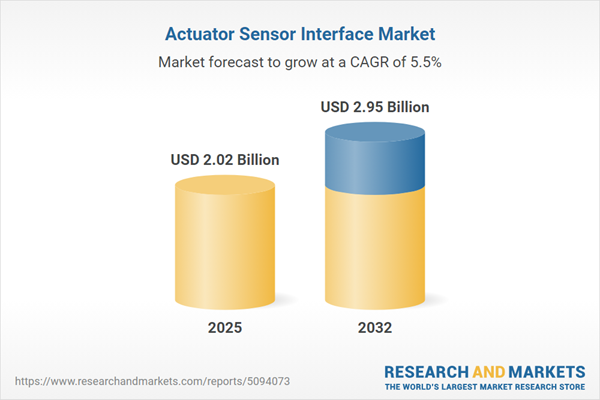Speak directly to the analyst to clarify any post sales queries you may have.
The actuator sensor interface market is pivotal in supporting digital transformation across manufacturing, automotive, healthcare, and consumer electronics. As organizations advance automation and smart device strategies, these interfaces have become essential for enabling reliable, real-time data and effective device operation.
Market Snapshot: Actuator Sensor Interface Market Growth
The actuator sensor interface market grew from USD 1.91 billion in 2024 to USD 2.02 billion in 2025, and is forecast to expand at a CAGR of 5.53%, reaching USD 2.95 billion by 2032. This market is experiencing steady gains as digitalization, edge computing, and the proliferation of connected devices accelerate end-to-end automation adoption. Demand is expanding in sectors that value precision, such as automotive safety, industrial control, and medical technology, underpinning a robust outlook driven by new regulatory and operational requirements.
Scope & Segmentation
This comprehensive research evaluates the actuator sensor interface market by technology, application, region, and key industry players, offering clear segmentation for targeted analysis and strategic planning.
- Interface Types: Analog (current output, voltage output) and Digital (CMOS, LVDS, TTL) interfaces are addressed to meet varying system integration needs.
- Communication Protocols: Fieldbus (CAN, Modbus, Profibus), Serial (RS-232, RS-485), and Wireless (Bluetooth, Wi-Fi, Zigbee) protocols serve a spectrum from industrial networks to mobile devices.
- Technology Types: Capacitive, MEMS (inertial, pressure, ultrasonic), Piezoelectric (differential, direct), and Resistive interfaces power advanced sensing and actuation platforms.
- Applications: Automotive (ADAS, engine control, safety), Consumer Electronics (smartphones, wearables), Healthcare (diagnostics, patient monitoring), and Industrial Automation (process control, robotics) represent core market drivers.
- Regions: Americas (including North America and Latin America), Europe, Middle East & Africa (EMEA), and Asia-Pacific, with specific attention to localized demand patterns and regulatory landscapes.
- Key Industry Players: Texas Instruments, STMicroelectronics, Infineon Technologies, NXP Semiconductors, Analog Devices, Renesas Electronics, ON Semiconductor, Microchip Technology, Allegro MicroSystems, Melexis.
Key Takeaways for Decision Makers
- Collaboration across semiconductor vendors, system integrators, and software developers is fueling innovation in actuator sensor interfaces, clearing the path for modular, user-centric solutions.
- The convergence of AI, IoT integration, and advanced signal processing is driving adoption of real-time, self-calibrating interfaces that minimize latency and enhance interoperability.
- Regulatory evolution—especially regarding electromagnetic compatibility and functional safety—continues to reshape design and procurement strategies, with compliance-tied product development cycles shortening as a result.
- Shifting supply chain models are pushing organizations to diversify sourcing, invest in nearshoring, and establish tariff-exempt partnerships to improve supply chain resilience and cost structures.
- Segmented insights reveal demand for digital interfaces and flexible protocols in emerging applications, as well as the need for ruggedized technologies in harsh or regulated environments.
- Regional market trajectories are influenced by local manufacturing bases, regulatory frameworks, and the integration of wireless or edge solutions in urban, industrial, and healthcare settings.
Tariff Impact on Supply Chain and Sourcing
The introduction of United States tariffs in 2025 has increased complexity in sourcing key components for actuator sensor interfaces. These tariff changes are prompting dual-sourcing strategies, shifts toward nearshoring, and realignment of vendor partnerships. Distributors are revising pricing and negotiating service agreements to address increased costs, while manufacturers focus on creating more resilient, geographically diversified supply networks. Proactive risk mitigation now includes transparent customs processes and enhanced collaboration with regional partners.
Methodology & Data Sources
Research is based on primary interviews with senior executives, engineers, and procurement specialists, supported by validated secondary data from industry publications, regulatory filings, and economic reports. Triangulation and scenario planning techniques strengthen accuracy and reliability throughout the report.
Why This Report Matters
- Provides leaders with actionable strategies to advance adoption, streamline compliance, and enhance supply chain resilience in the actuator sensor interface market.
- Enables benchmarking of interface technologies, protocols, and regional trends for targeted investment and innovation planning.
- Supports product development and sourcing decisions with comprehensive segmentation and up-to-date regulatory insights.
Conclusion
The actuator sensor interface market continues to advance as foundational enabler for automation and digital transformation. Strategic alignment, technology innovation, and regulatory adherence are key to unlocking sustained value and market leadership in this dynamic sector.
Additional Product Information:
- Purchase of this report includes 1 year online access with quarterly updates.
- This report can be updated on request. Please contact our Customer Experience team using the Ask a Question widget on our website.
Table of Contents
3. Executive Summary
4. Market Overview
7. Cumulative Impact of Artificial Intelligence 2025
Companies Mentioned
The companies profiled in this Actuator Sensor Interface market report include:- Texas Instruments Incorporated
- STMicroelectronics N.V.
- Infineon Technologies AG
- NXP Semiconductors N.V.
- Analog Devices, Inc.
- Renesas Electronics Corporation
- ON Semiconductor Corporation
- Microchip Technology Incorporated
- Allegro MicroSystems, Inc.
- Melexis N.V.
Table Information
| Report Attribute | Details |
|---|---|
| No. of Pages | 194 |
| Published | October 2025 |
| Forecast Period | 2025 - 2032 |
| Estimated Market Value ( USD | $ 2.02 Billion |
| Forecasted Market Value ( USD | $ 2.95 Billion |
| Compound Annual Growth Rate | 5.5% |
| Regions Covered | Global |
| No. of Companies Mentioned | 11 |









